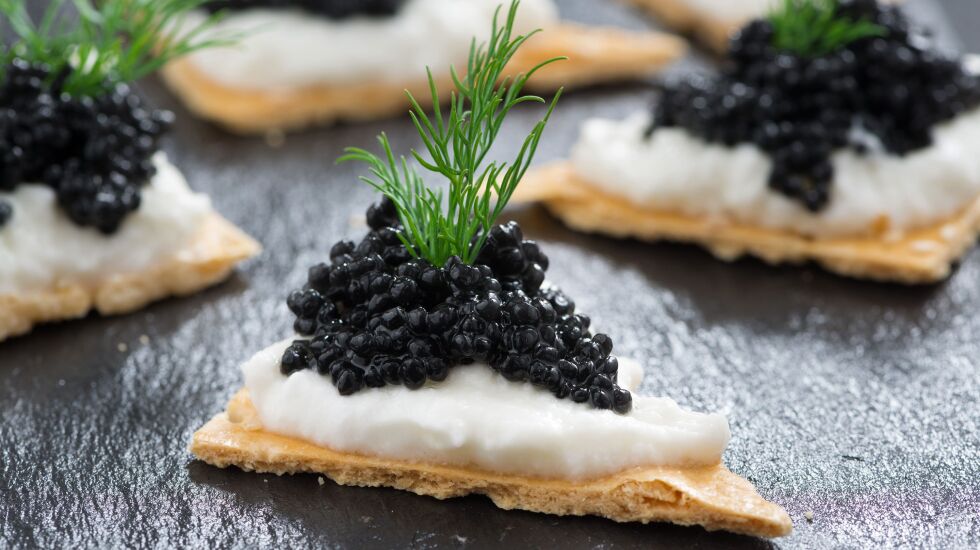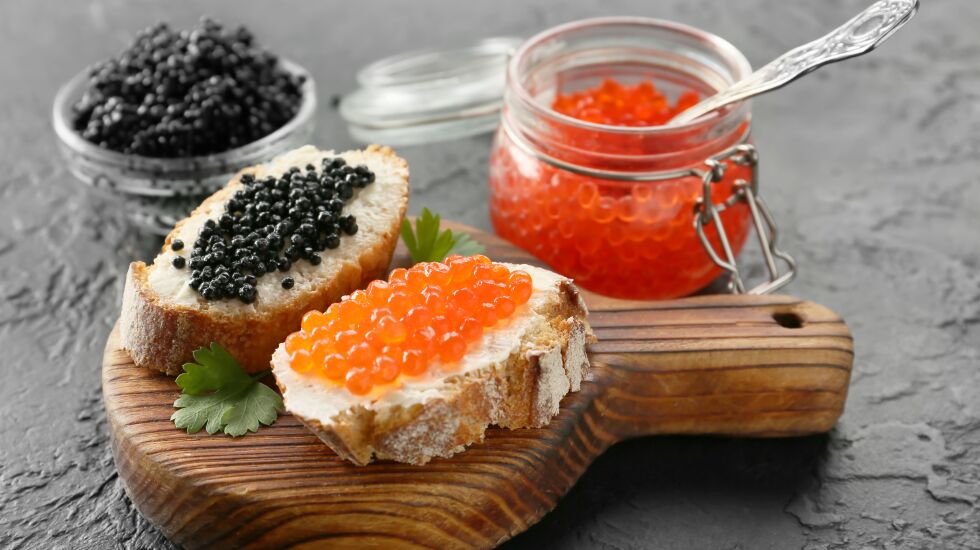
The world of caviar is one of luxury, an intricate harvesting process and high-priced tins of the delicacy.
The United States produced 18 metric tons, or nearly 40,000 pounds, of caviar in 2018. European countries produced 164 metric tons of caviar in the same year, accounting for 84% of total production, according to a report from the European Market Observatory for Fisheries and Aquaculture Products.
Caviar is served at many of the world’s five-star restaurants and hotels, a luxury staple on menus of fine-dining establishments. But what is caviar actually made of? Read on to learn more.
What is caviar?
Known to the world as a delicacy, caviar is unfertilized fish eggs with a salty taste. The eggs come from wild sturgeon, a fish in the Acipenseridae family that is found most often near Russia, Ukraine and North America.

A sturgeon can release several million eggs at once, and are either caught in the wild or monitored in fish farms. These are some of the most common types of caviar:
Beluga caviar: From the Beluga sturgeon native to the Caspian Sea. The Beluga sturgeon can reach lengths of 15 feet. Beluga caviar has a rich flavor and is gray or dark.
Ossetra caviar: From Ossetra sturgeon, this caviar is brown or golden and has a salty, sea taste.
Sevruga caviar: From Sevruga, Sterlet and Siberian sturgeon, this caviar is small with a buttery flavor.
American caviar: From lake sturgeon, wild Atlantic sturgeon and white sturgeon.
Caviar is a type of fish roe, a term that describes the eggs from different types of fish, Mashed reports. While caviar comes from sturgeon, Tobiko roe comes from flying fish and is served with sushi. Masago roe comes from smelt, small fish similar to trout in structure. Ikura, also called red caviar, refers to salmon eggs. These three types of roe are sometimes confused or substituted for caviar.
Why is caviar so valuable?
Caviar’s luxury status is in part thanks to overfishing in the late 1980s and early 1990s. The collapse of the Soviet Union and its Ministry of Fisheries meant caviar harvesting could become a free market, and there were more countries than ever trying their hand at caviar production. Esquire reports overfishing, pollution and new dams restricting the movements of sturgeon caused a 70% decline in commercial catches between 1978 and 1994.

Because of overfishing, habitat loss and illegal caviar trade, sturgeons are endangered. According to the World Wildlife Fund, they are the most endangered species on the Earth.
Rising sturgeon farms only furthered caviar rarity because of how complicated the harvesting and growing process is. Some large sturgeon take as long as 18 years to mature and start producing eggs. The minimum maturity time is about eight years.
Sturgeon are also prone to bacterial and fungal infections, Esquire writes, and the process of harvesting and handling eggs is a delicate one because they’re easily perishable.
How much does caviar cost?
At the very lowest, caviar runs at about $50 to $75 per ounce. That’s about enough for a few bites shared between two people, Serious Eats reports.
Some are more expensive — OLMA prices Beluga caviar at $122.55 for an ounce, or you can buy 17.6 ounces for a grand total of $1,946.55. If you’re in the market for special reserve Ossetra caviar, Petrossian sells one serving size for just over $400. For a party, check out the 16-32 person helping at $12,900.
How do you eat caviar?
With a salty, briny and buttery taste, caviar is often paired with cheese, eggs, fruit, butter or crackers. Caviar Guide recommends creamy cheeses or a smooth cheese like Asiago, Camembert or Gouda. Diners are supposed to enjoy caviar in small bites.
Caviar is served cold and needs to be delicately handled. Metal and stainless steel may be too rough or run the risk of transferring unintended flavors during oxidation.
Read more at usatoday.com







